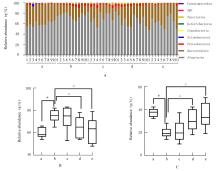| 1 |
VECCHIÉ A, DALLEGRI F, CARBONE F, et al. Obesity phenotypes and their paradoxical association with cardiovascular diseases[J]. Eur J Intern Med, 2018, 48: 6-17.
|
| 2 |
YE Z, LIU G, GUO J, et al. Hypothalamic endoplasmic reticulum stress as a key mediator of obesity-induced leptin resistance[J]. Obes Rev, 2018, 19(6): 770-785.
|
| 3 |
DAO M C, CLÉMENT K. Gut microbiota and obesity: concepts relevant to clinical care[J]. Eur J Intern Med, 2018, 48: 18-24.
|
| 4 |
CHOI S, HWANG Y J, SHIN M J, et al. Difference in the gut microbiome between ovariectomy-induced obesity and diet-induced obesity[J]. J Microbiol Biotechnol, 2017, 27(12): 2228-2236.
|
| 5 |
吴振宁, 祁龙凯, 陈地灵. 茯苓提取物对高脂饮食致肠道菌群失调小鼠的影响[J]. 中国现代中药, 2020, 22(11): 1822-1829.
|
| 6 |
晏 敏, 周 宇, 贺肖寒, 等. 柑橘籽中柠檬苦素及类似物的生物活性研究进展[J]. 食品与发酵工业, 2018, 44(2): 290-296.
|
| 7 |
GU M, SUN J, QI C, et al. The gastrointestinal fate of limonin and its effect on gut microbiota in mice[J]. Food Funct, 2019, 10(9): 5521-5530.
|
| 8 |
郑绪阳, 黄先玫. 建立雄性营养性肥胖幼鼠模型的研究[J]. 中国预防医学杂志, 2011, 12(2): 146-148.
|
| 9 |
姚凤云, 钟 琦, 吴莹莹, 等. 基于INSR/PI3K/AKT信号通路的加味温胆汤抗雌性幼鼠营养性肥胖机制研究[J]. 中药药理与临床, 2021, 37(3): 26-29.
|
| 10 |
POOROLAJAL J, SAHRAEI F, MOHAMDADI Y, et al. Behavioral factors influencing childhood obesity: a systematic review and meta-analysis[J]. Obes Res Clin Pract, 2020, 14(2): 109-118.
|
| 11 |
郑 毅, 贺 琪, 李玉波, 等. 儿童肥胖与肥胖基因单核苷酸多态性的关系研究[J]. 中国医药导报, 2020, 17(23): 8-11, 19.
|
| 12 |
袁 琦, 兰超美. 儿童肥胖症的影响因素及干预措施研究进展[J].临床检验杂志(电子版),2020,9(3):498-499.
|
| 13 |
WEIHRAUCH-BLÜHER S, WIEGAND S. Risk factors and implications of childhood obesity[J]. Curr Obes Rep, 2018, 7(4): 254-259.
|
| 14 |
WEIHRAUCH-BLÜHER S, SCHWARZ P, KLUSMANN J H. Childhood obesity: increased risk for cardiometabolic disease and cancer in adulthood[J]. Metabolism, 2019, 92: 147-152.
|
| 15 |
SON J W, KIM S. Comprehensive review of current and upcoming anti-obesity drugs[J]. Diabetes Metab J, 2020, 44(6): 802-818.
|
| 16 |
HUANG S J, LIU X Y, XIONG B, et al. Variation in limonin and nomilin content in citrus fruits of eight varieties determined by modified HPLC[J]. Food Sci Biotechnol, 2019, 28(3): 641-647.
|
| 17 |
FAN S M, ZHANG C L, LUO T, et al. Limonin: a review of its pharmacology, toxicity, and pharmacokinetics[J]. Molecules, 2019, 24(20): E3679.
|
| 18 |
尤文挺, 王 洒, 何 龙, 等. 柠檬苦素单体的药理活性研究进展[J]. 中药材, 2017, 40(1): 242-246.
|
| 19 |
BAOTHMAN O A, ZAMZAMI M A, TAHER I,et al. The role of Gut Microbiota in the development of obesity and Diabetes[J]. Lipids Health Dis, 2016, 15: 108.
|
| 20 |
FAVA F, GITAU R, GRIFFIN B A, et al. The type and quantity of dietary fat and carbohydrate alter faecal microbiome and short-chain fatty acid excretion in a metabolic syndrome ‘at-risk’ population[J]. Int J Obes (Lond), 2013, 37(2): 216-223.
|
| 21 |
WANG H S, NI X Q, QING X D, et al. Live probiotic Lactobacillus johnsonii BS15 promotes growth performance and lowers fat deposition by improving lipid metabolism, intestinal development, and gut microflora in broilers[J]. Front Microbiol, 2017, 8: 1073.
|
| 22 |
杨 莉, 杨卫星, 张智芳, 等. 高通量测序研究德昂酸茶对高脂饮食小鼠肠道微生物的影响[J]. 扬州大学学报(农业与生命科学版), 2020, 41(2): 100-106.
|
| 23 |
郑 帅, 朴春梅, 张 芝, 等. 强化玉米饮食对小鼠肠道菌群结构和功能的影响[J]. 微生物学报, 2019, 59(9): 1714-1722.
|
 )
)









